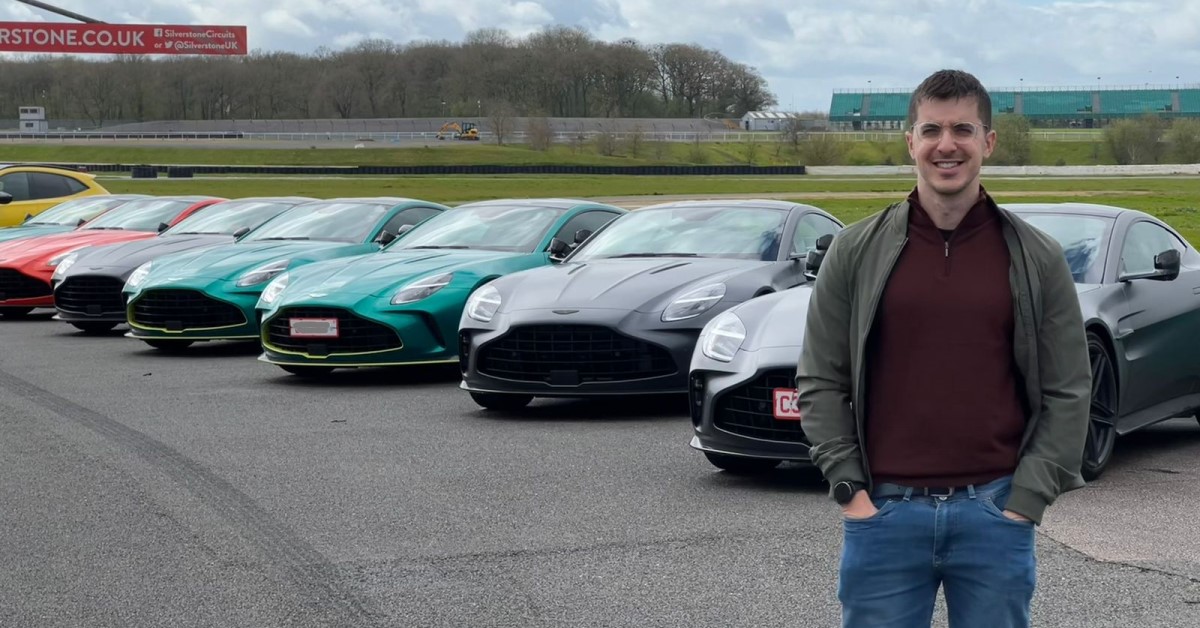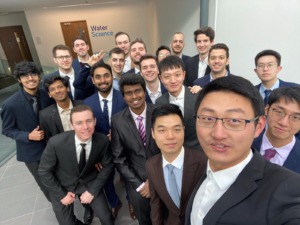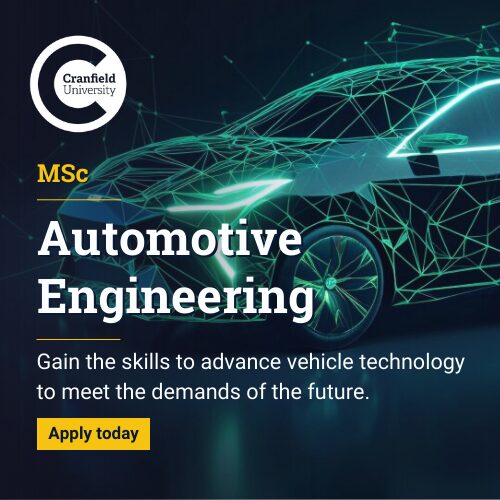Automotive Engineering MSc alumnus Christos Patrinos on his journey from Cranfield to Aston Martin
18/06/2024

Christos Patrinos is a Chassis Simulation Engineer at Aston Martin. He graduated from Cranfield University with an MSc in Automotive Engineering in 2020. Here, Christos talks about his lifelong interest in fast-moving machines, the positive impact coming to Cranfield has had on his career, and what his role at Aston Martin looks like.
What sparked your interest in the automotive industry?
From a very young age, I developed a keen interest in fast-moving, noisy machines. High-performance vehicles, in particular, captivated me with their sleek designs and exhilarating speed. This fascination led me to pursue a degree in mechanical engineering in Greece and later specialise in the automotive field with an MSc at Cranfield University.
Why did you choose Cranfield and the Automotive Engineering MSc course?
I chose Cranfield University for my postgraduate studies because of its stellar reputation for several of its courses and strong industry connections. I believed that at Cranfield, I would have the opportunity to tackle real-world problems, utilise industry-relevant tools, and work on projects provided by OEMs. My initial belief proved to be absolutely true, as Cranfield thoroughly prepares you for the industry you are studying for.
Among the available courses, I selected the Automotive Engineering MSc course because it offered a comprehensive overview of the car as a product without limiting me to a specific specialisation. This broad perspective was exactly what I was looking for, and I had the chance to specialise through my thesis work.
 How did you find the course? What were the highlights?
How did you find the course? What were the highlights?
The course provides a comprehensive overview of the car as a product, covering modules such as vehicle dynamics, controls, structures, materials, powertrain and more. Each module presents industry-related problems, encouraging rigorous analysis using appropriate tools while understanding the limitations of the solutions.
One of the major highlights was the Group Design Project. In our year, we worked on converting a conventional ambulance into a BEV version. This was a challenging task, requiring efficient teamwork (with 22 students per group) and the development of viable solutions to be presented at an acceptable level by the end of the project.
The final part of the course involved selecting a thesis topic. I chose a topic with Aston Martin on vehicle dynamics and control, aligning with my desired specialisation. This project was critical for my career in the field. Without this selection, I would likely not be in my current role.
The thesis aimed to determine how to combine different actuations in overactuated systems to achieve specific targets. Essentially, it explored how various actuation methods could influence vehicle dynamics to meet a given target under different conditions. Additionally, I proved that my proposed solution could improve lap times around the Silverstone GP track. This required reviewing extensive academic literature, developing my own solution, and discussing feedback with my supervisors at Cranfield and Aston Martin weekly, showcasing results via simulation. It helped me appreciate the complexity of controlling a car with fast dynamics at the limit and understanding the challenge of achieving real-time solutions.
What has been your career path since graduating?
Immediately after graduating from Cranfield, I was offered a position as a researcher at Cranfield University. I worked on a joint project with Cranfield University, Aston Martin, and another company specialising in hydropneumatic actuators. The project’s goal was to investigate how an innovative suspension concept could improve the handling and ride characteristics of Aston Martin vehicles through simulation. This eight-month project was highly engaging and helped me acquire additional skills in simulation and controls. It also allowed me to merge my academic background with real-world problem-solving, aligning perfectly with my initial goal when I chose to study at Cranfield.
Following this role, I was offered a position at Aston Martin as a Chassis Simulation Engineer.
You currently work as a Chassis Simulation Engineer at Aston Martin. Can you tell us more about your role?
The title Chassis Simulation Engineer essentially refers to a Vehicle Dynamics and Controls CAE Engineer. My role involves the theoretical study of the vehicle, aiming to provide feedback on what affects its performance. Specifically, my team investigates the impact of crucial components such as tyres and suspension along with the aerodynamics, and powertrain. We develop integrated simulation models to study these aspects and understand their impact on the overall vehicle system. We are also responsible for generating the requirements for control system development. More specifically, I have had the chance to work on active aerodynamics, torque vectoring, and active differential.
We are heavily involved from the early development phases (proof of concept) where through our studies we attempt to understand how to achieve specific vehicle-level targets, to the later stages, where we validate our models using data from the first prototype vehicles. This process allows us to provide feedback for further development and address potential issues. Additionally, we play a significant role in mid-cycle facelifts, making improvements to existing products.
One of our key responsibilities is operating and maintaining a real-time driver-in-the-loop simulator. This tool allows us to test our solutions with feedback from racing drivers, accelerating the development process by identifying and mitigating potential issues without needing an actual car in the early stages. These issues can be related to tyres, suspension setup, evaluation of a control logic and its impact on the car, among other factors.
Moreover, we develop virtual tools to analyse experimental data from vehicles. These tools help us understand the performance of our products, quantify the driver’s subjective experience into KPIs, benchmark against competitors, and predict the market reception of future products based on their driving characteristics.
Overall, my team plays a critical role in defining processes and standards for vehicle evaluation. We are responsible for designing experimental tests that provide the company with a comprehensive understanding of its products’ performance.
What does a typical week look like for you?
A typical week involves conducting various studies to gain insights into vehicle performance. This can range from simple tasks, such as understanding the grounding effect around Nürburgring of a specific suspension setup under a particular aerodynamic package, to more complex activities like vehicle model correlation using experimental data.
A typical week can also include sessions at the simulator to gather feedback from drivers on solutions for active aerodynamics or torque vectoring, for example. I also spend time developing tools to automate processes, which enhances efficiency in our workflow.
Additionally, I have the opportunity to travel to various supplier sites. This includes trips to Spain for testing or to Italy to collaborate with suppliers to enhance our simulation capabilities or to Germany for aerodynamic testing. These experiences provide valuable insights and contribute to the continuous improvement of our vehicle development process.
What would you say to someone who wants to work in the automotive industry?
The automotive industry is fascinating, with many complex problems to solve. These problems often require solutions that must address numerous constraints, such as budget, packaging, safety, durability, performance, comfort, and, most importantly, time constraints. This complexity may not be fully appreciated during your studies, but it truly highlights the essence of engineering.
Working in this industry provides the opportunity to develop skills that make you a competitive engineer. Many methodologies used in the automotive sector can be applied, with some adjustments, to other industries facing similar constraints. Moreover, the tools used are similar between the automotive industry and other industries.
The key to success is a solid understanding of basic engineering principles. Even the most complex problems can be broken down into simpler issues that require a strong foundation in these fundamentals. Coupled with passion, a continuous desire to develop, and a drive to succeed, these qualities will help you excel in your engineering career.
What do you think the future holds for the automotive industry?
The future of the automotive industry is already unfolding before us. Electrification of powertrains has begun to play a significant role, and I believe hydrogen will become more prominent in the coming years. Energy management presents a fascinating engineering challenge that will need even more attention in the near future.
Autonomy is another major component of modern and future vehicles. As we collect more data and improve artificial intelligence, autonomous features will become increasingly standard across all vehicles. This shift will transform how we think about mobility and vehicle functionality.
Additionally, the integration of advanced connectivity features, the development of sustainable materials, and the emphasis on reducing the environmental impact of vehicles will continue to shape the industry’s trajectory. The automotive sector is poised for significant advancements, making it an exciting field for innovation and engineering.
Categories & Tags:
Leave a comment on this post:
You might also like…
Preparing your work for Turnitin submission
Before submitting your work into Turnitin for similarity checking, if you have used referencing software then you may need to take some important steps first. Mendeley and Zotero integrate with MS Word by embedding field ...
The fast track to supercar engineering: My Cranfield journey
It’s been a dream come true to work on some of the world’s most prestigious supercars – the Aston Martin Valhalla, McLaren 750 & Artura, the GMA T.33. But every successful ...
Automotive Engineering: From student to hypercar innovation at Rimac
We sat down with recent graduate Thomas Perrin, to discuss how his year on the MSc in Automotive Engineering at Cranfield University propelled him from the lecture hall directly into the ...
What this year at Cranfield really meant to me
Every Cranfield journey is unique. In this alumni reflection, Zachea Scicluna shares what her year at Cranfield truly meant, from facing uncertainty to gaining hands-on experience in industry-backed projects. I’ve been reflecting (and delaying) ...
Preparing for assignments and exams?
Sorry! We know it seems a bit mean to mention the exams in January rather than looking forward to the break before it! However, we know many of you will be thinking about your forthcoming ...
Screening for FTSE 100 companies on Bloomberg
So you’re researching an index and need some data on its constituent companies? Bloomberg’s Equity Screening tool makes light work of this, not just for the FTSE, but for indices, exchanges and sectors worldwide. Type EQS ...







